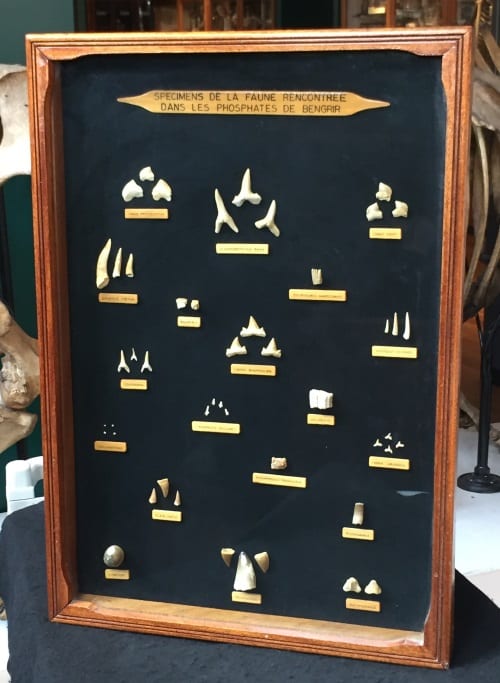Specimen of the Week 253 : Moroccan phosphate fossils
By Tannis Davidson, on 19 August 2016
This week’s Specimen of the Week is not one, but 48 individual specimens which make up a display box highlighting various fossil teeth from Morocco. Display boxes of this sort are not uncommon as they are a visually appealing way to showcase numerous small specimens not to mention an entrepreneurial solution to add value to otherwise inexpensive individual fossils. The Grant Museum’s display box is a rather nice example of this type containing fossil teeth of 19 different species of fish and marine reptiles:
As indicated by the label, these fossils were found in the phosphates of Bengrir (Benguerir), a small city located about 70km north of Marrakesh. This area is one of the major phosphate basins in Morocco – a country which is the world’s 3rd largest producer of phosphate and contains about 75% of the world’s estimated reserves 1. Phosphate rocks contain high concentrations of phosphate minerals which are mined to produce phosphate fertilisers for the agricultural sector. It is the resource which drives modern agriculture.
Morocco’s vast phosphate resources (found mainly in the western part of the country) are found in Upper Cretaceous, Paleocene and Eocene sediments which also yield abundant fossil deposits from this time (around 70-45 million years ago). These fossils are the byproduct of phosphate extraction and include marine vertebrates (sharks, bony fish, reptiles), sea birds and a small number of terrestrial mammals.
Included in the Grant Museum’s phosphate fossil display box are teeth from three species in the group of large marine reptiles known as mosasaurs: Mosasaurus, Globidens, and Platecarpus. Shark teeth include those from the goblin shark-like Scapanorhynchus, eagle-ray Myliobatis, and the sand shark Odontaspis. There are also fish teeth from the fanged Enchodus lybicus and Enchodus elegans and individual ‘saw’ teeth from the primitive saw fish Ctenopristis nougareti.
Unusually for fossil teeth display boxes of this type, the Grant Museum’s specimen has wood labels including those which name the individual species (rather than the far more common printed paper labels found on the presently-available retail variety). The simple, but elegantly detailed frame also differs from its modern counterparts and may suggest an older heritage.
The Museum’s associated documentation with this specimen doesn’t include a date of entry into the collection however, the Benguerir Mine was only opened in 1979 so it is possible that this display box, if the fossils came from the mine, is at most 37 years old – making it one of the Grant Museum’s ‘newest’ specimens. Then again, ‘Rencontrée dans les Phosphates de Benguerir’ does not mention a mine and it is just as likely that these were manually dug up or found on the surface in the area.
A quick search of the validity of the taxonomies reveals that Lamna biauriculata is not a recognised name. Cretolamna biauriculata is the valid name for this species wherby ‘Cretolamna‘ was designated in 1958 (Glikman) and attached to the species biauriculata (Wanner 1902). So it is possible that this display box (or rather, its labels) dates to before 1958 (if the latest developments in taxonomies were followed by the maker). Perhaps a forensic wood specialist or frame maker should be consulted…
In any case, it is a nice little comparative selection of Moroccan phosphate fossils which not only illustrates the diversity of teeth in marine species from these deposits, but by extension, the diversity of life which swam in the ancient seas so long ago.
Tannis Davidson is the Curatorial Assistant at the Grant Museum of Zoology
References
- “Morocco Energy and Mining”. Morocco Business News. Retreived online 2016-08-18. http://www.moroccobusinessnews.com/Sectors/Energy_Mining.asp
 Close
Close




